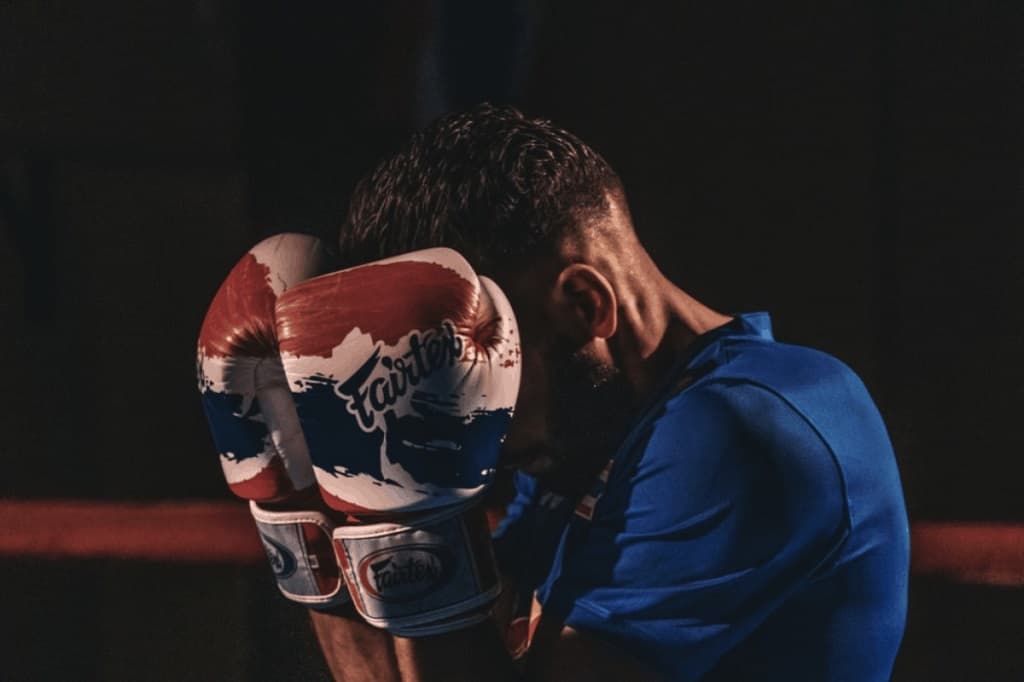
Hello again Warriors! Welcome back to another day where we talk about the mechanics of boxing. Today, we’re talking about protecting yourself with defense so that you won’t get your face punched in.
Defense is extremely important in the sport of boxing. Without it, you wouldn’t be able to protect yourself against the punches from your opponent. But how exactly do you do that? What does good defense look like in boxing?
In boxing, defending yourself involves keeping your hands up in front of your face and weaving left and right. It is all for the purpose of not getting punched by your opponent. In the grand scheme of things, defending yourself is actually more important than KO’ing your opponent. So in order to get better at protecting yourself, there are some specifically designed drills that you can try to help you become a pretty hard guy to punch. In the words of former heavyweight champion Rocky Marciano, “The best fighters hit the most and get hit the least.”
Here are some different ways you can protect yourself in a fight:
- BOB AND WEAVE
- BLOCKING
- COUNTER
- GOOD FOOTWORK
- SPARRING
- SHADOWBOXING
- MOVE HEAD
- KNOW HOW TO HOLD PUNCH MITTS
- SELF-CONDITIONING
Now, I’m no boxing expert, but I have a burning passion for the sport and I will tell you what I know, so read on to learn more!
Bob and Weave
I learned this technique at Title Boxing. My trainer would call it, “roll under.” Basically, this maneuver is where you duck your head down and move from side to side to dodge your opponent’s punches. The bob is where you move your head up and down, and weaving is where you move from side to side.
This video by the Fight your way Fit YouTube channel shows what the Bob and Weave move looks like. The Bob and Weave (step by step for beginners)
Remember to keep your core engaged at all times when you’re doing this exercise.
Blocking
In boxing, blocking is more than just holding your hands in front of your face and mid-section. You do have to do a little bit more moving around, depending on what kind of punches your opponent will try to land on you. Your opponent might throw a hook, or an uppercut. So you will have to execute different blocking moves on them.
Here are the different kinds of punches and how you can block them:
- BLOCK A JAB: Move your rear hand in front of your face to block a jab. Remember not to cover your eyes, as you still need to maintain eye contact with your opponent.
- BLOCK A CROSS: You could use the same blocking technique to block a jab for this, but there is a more effective way you can block a cross.
- BLOCK A LEFT HOOK TO THE HEAD: When blocking a hook, you don’t want to extend your arm to try and karate block the punch, because your opponent can still land the punch around your arm. Instead what you want to do is raise your rear hand and shoulder up, about in line with your ear.
- BLOCK A RIGHT HOOK TO THE HEAD: Just like with blocking a left hook, raise your hand and shoulder up towards your ear to block the punch. Again, don’t try to reach out and block the punch. Your opponent can still punch you in the head if you do that.
- BLOCK A LEFT HOOK TO THE BODY: This is where the weaving comes into play. Weave to your right (your opponent’s left) while keeping your rear hand in its guard position to block the hook.
- BLOCK A RIGHT HOOK TO THE BODY: Like with the left hook to the body, weave to your left (your opponent’s right) while keeping your lead hand in the guard position. Don’t try to catch the punches, because then you’ll be leaving your face vulnerable to get punched.
- BLOCK AN UPPERCUT: You can block an uppercut 1 of 2 ways. The first is that you can slightly move your rear hand in front of your face with the palm facing down to block the punch. The other way you can block an uppercut is similar to blocking a body punch, by weaving. Only this time, you want to turn your torso in the direction of your rear hand to dodge the punch.
This video by Fight your way Fit shows all the blocking techniques in action. How to Block Punches (step by step for beginners)
Countering
For starters, a counter in boxing is where you block a punch and then retaliate with a punch of your own. Be ready for your opponent to throw a punch. React accordingly to what kind of punch it is (jab, cross, hook, uppercut) and block it. Then quickly throw a punch back onto your opponent. That’s one way, called the catch and counter. It takes practice to do correctly, and you have to time it. If you’re not quick enough with your counter punch, your opponent might dodge it or block it.
There are other ways you can counter, by dodging a punch and then punching. For example, suppose your opponent throws a hook to the head. One counter move you could try is bob your head down, and then punch. If you time it just right, you can land an uppercut that could win the fight for you.
Here are 2 videos showing you some of the different types of counters:
Boxing | How To | 3 Different Types of Counter Punches in Boxing
How to Counterpunch for Beginners
Good Footwork
I wrote a post about how to have good and quick footwork while in the ring, you can check it out here: How to Improve Your Footwork for Boxing – be Quicker!
When it comes to protecting yourself, being quick on your feet will keep you from getting punched repeatedly. There is a chance you might still get punched. (Let’s face it, nobody ever steps foot in the ring and steps back out completely unscathed!)
Different ways you can improve your footwork include jumping rope, box jumps, and agility ladders. Click on my post about footwork to learn more.
Sparring
It doesn’t get any better than sparring in the ring with a partner. It’s like the ultimate win-win scenario, as you both can do drills together, you can challenge each other, and you can alternate between who does what. Plus it is the best way to practice what you will be up against going into your next fight.
If you’re sparring with a partner, all the different skills you learned beforehand will be put to the ultimate test. As long as you keep in the back of your mind, speed over power, and brain over brawn. However, if you’re a fighter who boasts brawn and brains, then you might be a pretty lethal fighter.
Shadowboxing
Shadowboxing is an exercise I have done at Title Boxing every time I go there. There are mirrors in the facility so that we can check our form, just like in a normal gym. Shadowboxing is where you practice all the different techniques of boxing by yourself, so that you can check your form and be your own trainer.
Personally, doing this kind of stuff can help you if you do it on your own, but sometimes it is worth it to have a trainer. Having a trainer means you can have a partner who has a high fighting IQ and knows exactly how to coach you. But beware, the cost of a trainer can be pricey.
What I do is I practice the different kinds of moves in front of a mirror, both fast and slow. I start out slow with my moves, and then I go faster when I think I got the hang of it.
Moving Your Head
This is an extremely critical component to your defense. Your head and face must be protected at all times. So how do you protect it? Well, one way you can protect it is by moving your head out of the way of the punches.
According to Breaking Muscle’s blog about improving defense for boxing, 5 Ways to Improve Your Defense and Win More Fights, while blocking a punch to the head is a good defensive technique, it is better for you if your opponent’s punch is a miss because you moved your head out of the way. A moving target is harder to hit than a stationary target, right?
Holding Focus Mitts
According to the Breaking Muscle blog, holding focus mitts will help you get to know your opponent and his tendencies. It can also help you work on blocking, and it will let you feel what it’s like to get punched. That way, you’ll know what you’re up against when you step in the ring.
When you’re the one using focus mitts, it’s you who is in control of the drills. You control the speed and the types 0f punches thrown from your partner. This video from the Precision Striking YouTube channel shows you how to use the punch mitts with visual aids. Beginner Boxing Pad Drills | Also for Shadow Boxing or on the Heavy Bag
Conditioning
The Breaking Muscle blog suggests 2 ways that you can condition yourself to get hit. I for sure did one of these methods at Title Boxing, and that is to do shadowboxing with light dumbbells. I would recommend you use a maximum weight of 5 pounds. Don’t go any heavier. In my experience, we would use the weights to add resistance to certain moves, like simply keeping our hands up to protect the head, doing jumping jacks, burpees, punches, you name it.
The second way you could condition yourself is using a medicine ball to throw into your gut. For this drill, you need a partner. You and your partner take turns throwing the ball to each other. Aim for the abdomen, as it is effective in building your core strength. Core strength is one of the most key components in boxing. So remember to tighten up that stomach!
Closing Words
You just learned many ways on how to become more defensive-minded and get punched less in your fights to come. Remember, it’s not so much about knocking your opponent out cold, it’s more about being fast and smart. If you can try to predict your opponent’s next move, your opponent will either miss or have their punches blocked by you every time. Don’t forget about that stomach, and don’t forget to breathe.
Got all that? Good! If you think you’re ready to glove up, then let’s GO INTO BATTLE!

